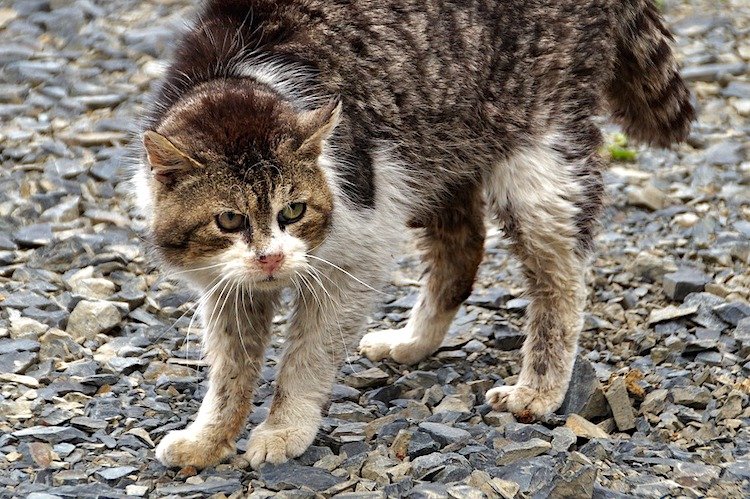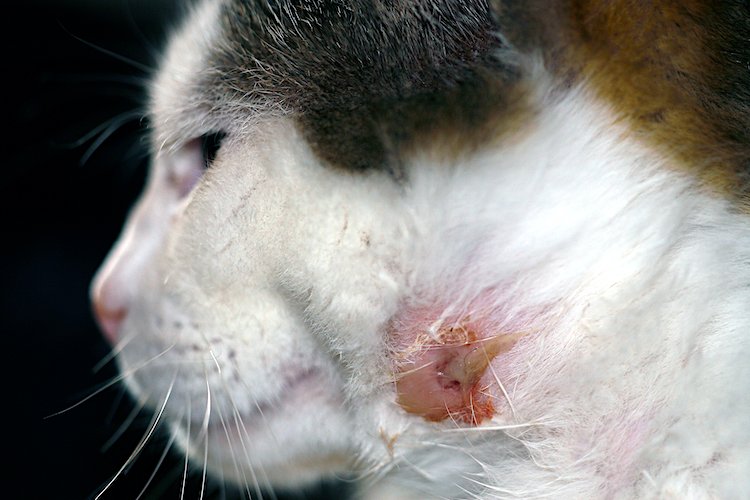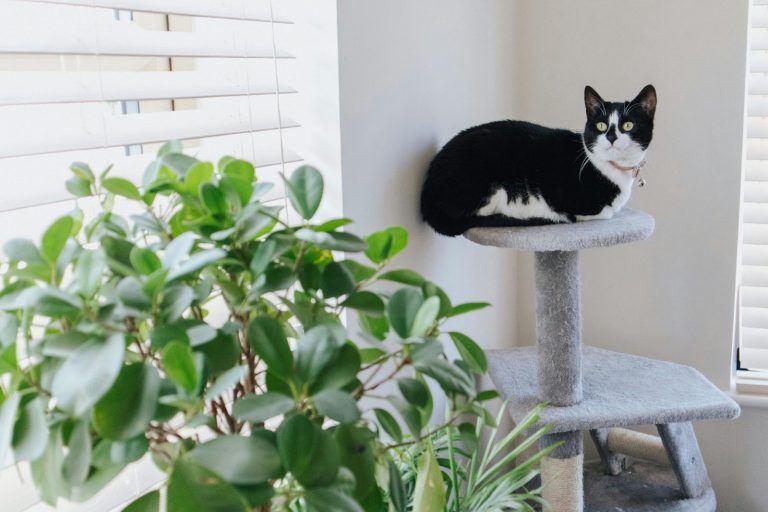Cat Abscess: Causes, Symptoms, and Effective Treatment Options
Learn about cat abscess causes, symptoms, and treatment options. Quick action can ensure your cat heals properly and prevents complications.
This pet health content was written by a veterinarian, Dr. Debora Lichtenberg, VMD. This article was originally published in 2012 and was last reviewed for accuracy and updated on December 11, 2024
If you have questions or concerns, call your vet, who is best equipped to ensure the health and well-being of your pet. This article is for informational purposes only and is not a substitute for professional medical advice, diagnosis or treatment. See additional information.


Don’t leave your pet’s safety to chance
Sign up for Petful recall alerts today.

What Causes a Cat Abscess?
Cat abscesses are a frequent issue, particularly in indoor/outdoor cats, where the risk of fights and injuries is higher. These abscesses result from:
- Cat fights: Bites and deep scratches inflicted during fights can inject bacteria into the skin and muscle, leading to infection.
- Other animal bites: Encounters with wildlife or other pets can also cause abscesses.
- Foreign objects: Cats may step on sharp objects, get impaled by fences, or get scratched by thorny bushes, all of which can lead to puncture wounds that develop into abscesses.
Indoor/outdoor cats face a higher likelihood of injuries. Learn more about the risks of outdoor living for cats by reading this guide on indoor/outdoor cat health.
Keeping cats indoors can help reduce the likelihood of such injuries and abscess formation.
What Is a Cat Abscess?
A cat abscess is a type of infection that develops beneath the skin, often caused by deep puncture wounds. These infections can fester and eventually break open if left untreated.
Here’s how a cat abscess forms:
- A deep puncture, such as a bite or scratch, allows bacteria to enter the wound.
- The bacteria multiply, leading to infection and inflammation in the affected area.
- Swelling typically develops around the wound site, signaling the formation of an abscess.
Cat abscesses can range from mild to severe, depending on factors like the depth of the wound and the type of bacteria involved. Learn more about what causes an infection by visiting this comprehensive guide on abscesses in cats.
Prompt treatment is crucial to prevent complications and ensure proper healing
What Does a Cat Abscess Look Like?
Cat abscesses typically appear as swollen areas under the skin. The size and texture can vary depending on several factors:
- Depth and seriousness of the wound: Deeper injuries may result in larger abscesses.
- Location on the body: Certain areas may swell more visibly than others.
- Type of bacteria: Different bacteria can affect the appearance and severity of the abscess.
- Time before detection: Abscesses that go unnoticed for longer may grow larger or worsen.
- Health status: Cats with conditions like FeLV or FIV may be more prone to severe abscesses due to compromised immunity.
How to Identify a Cat Abscess
The swelling may exhibit the following characteristics:
- It can be small or large or consist of multiple swollen areas.
- The area may be covered with fur or have no fur at all.
- It might appear shiny or have a visible scab.
- If the abscess has opened or burst, there will likely be drainage that can be clear, bloody, or pus-filled.
Cats with health conditions like FeLV (learn more about feline leukemia) or FIV (understand feline immunodeficiency virus) are more susceptible to complications, making early detection and treatment even more crucial.
Regularly inspecting your cat’s body for unusual lumps or swellings can help you catch an abscess early.

How Will My Cat Be Acting?
Here are a few more signs that your cat has an abscess:
- Some cats show no symptoms at all and you are the one that discovers the swelling while you are normally petting your cat.
- Lethargy: Abscesses often cause a fever, resulting in your cat acting sick. The cat may be sleeping too much or not eating.
- Limping or painful. Abscesses on the extremities or near joints can be quite painful and cause the cat to limp. Other cats show no pain until you inadvertently touch the abscess — and then the cat lets you know there’s something wrong.
- Licking excessively. Your cat may give you no indication that they have a wound or are in pain except for licking a specific area. Normal grooming is usually an all-over affair. Pay attention if your cat is excessively licking a paw, the tail base, etc. Chances are you will find evidence of an abscess.
Treating an Abscess on a Cat
Cat abscesses usually require a veterinary visit. Treating an abscess sooner than later usually means a better outcome for your cat’s health and your wallet.
Here’s what to expect:
- Your veterinarian will take the cat’s temperature and examine the abscessed area. Then a decision will be made about treatment. Mild abscesses in cats might be treated without sedation. If the abscess is minor and has already opened and is draining, the vet may be able to clean the wound and send your kitty home. Most abscesses, however, are more serious and will require sedation or anesthesia.
- With the cat sedated, the abscess and the surrounding area are shaved. The vet will then lance the abscess with a scalpel and explore the extent of the wound/abscess.
- The wound is flushed with sterile saline until it is as clean as possible.
- Every abscess is a little different. Sometimes skin that is not healthy has to be trimmed away. Sometimes a drain is placed to keep the ends of the abscessed area open to drain.
- Most abscesses are not sutured closed, but occasionally a large area must be partially closed with stitches.
- Your cat’s rabies vaccine may need to be boosted.
- The cat usually goes home the same day with a week of oral antibiotics.
Home Care for Your Cat’s Abscess
After a veterinarian has treated and drained the abscess, your cat should start feeling much better. While most cats don’t require extensive pain management, proper home care is essential for a full recovery.
Here’s how you can care for your cat’s abscess at home:
- Warm compresses: Apply warm compresses to the abscessed area a few times a day for 3–4 days to promote healing and keep the wound clean.
- Addressing scabs: If a scab forms over the abscess and the area begins to swell again, soften the scab with a warm compress and gently remove it. Always consult your vet if you’re unsure about the healing process—sending pictures can be helpful.
- Indoor confinement: Keep your cat indoors during the treatment period to prevent further injuries or infections. If the wound is messy, confine your cat to a room with washable bedding, food, water, and a litter box.
- Elizabethan collar: If prescribed by your vet, use an Elizabethan collar to prevent your cat from licking or scratching the wound.
Follow-Up Care
- Schedule a follow-up visit within a few days or a week to ensure the abscess is healing properly.
- If a drain was placed, it typically needs removal by the vet in 3–5 days.
- Sutures, if used, usually stay in for about 10 days.
By following these steps and maintaining close communication with your veterinarian, you can help your cat recover fully and avoid complication
Cat Abscess Treatment: When Things Go Wrong
Even with proper care and treatment, some cat abscesses may not heal as expected. Complications can arise, and it’s essential to monitor your cat closely during recovery.
Common Complications
- Antibiotic resistance: Some bacteria may not respond to the prescribed antibiotics, requiring alternative treatments.
- Infection pockets: Additional pockets of infection may form even after initial treatment.
- Health concerns: Older cats, those with FeLV, or cats with compromised immune systems may experience slower healing or more severe infections.
- Bone involvement: In rare cases, an abscess may spread to the bone, such as in the leg or jaw, necessitating more intensive treatment.
- Slow-healing areas: Abscesses in fatty regions, like the belly, tend to heal more slowly.
Warning Signs to Report to Your Vet
Contact your veterinarian immediately if you notice any of the following:
- Ongoing lethargy or lack of appetite: Most cats should feel better and regain energy after treatment. Persistent lethargy is a red flag.
- Excessive drainage or pus: Most abscesses stop draining within 1–2 days. Prolonged or heavy drainage could indicate further infection.
- Continued or new swelling: Swelling that does not subside or reappears may require additional treatment.
The Good News
Most cat abscesses heal quickly with proper care and monitoring. While some cases may require multiple vet visits or extended treatment, patience and persistence often lead to a full recovery.
Staying in close communication with your veterinarian and following their recommendations is key to addressing complications and ensuring the best outcome for your cat.ht get frustrated and be making multiple trips to the vet. Ultimately, these nasty cases just need more time and treatment to have a good outcome.
Frequently Asked Questions (FAQ)
How to treat a cat abscess at home?
Apply warm compresses, keep the area clean, and contact a vet for guidance; avoid attempting extensive treatment without professional advice.
Can a cat die from an abscess?
Yes, if left untreated, a severe abscess can lead to systemic infection (sepsis) and become life-threatening.
Can a tooth abscess kill a cat?
Yes, a tooth abscess can lead to serious complications, including systemic infection, if not promptly treated.
References
- Weir, Malcolm, DVM, MPH, and Robin Downing, DVM, DAAPM, DACVSMR, CVPP, CRPP. “Abscesses in Cats.” VCA Hospitals. https://vcahospitals.com/know-your-pet/abscesses-in-cats.
- Plotnick, Arnold, DVM, ACVIM. “Cat Bite Abscesses.” Manhattan Cat Specialists. Sept. 2019. https://www.manhattancats.com/blog/2019/september/cat-bite-abscesses/.
- Thayer, Vicki, DVM, DABVP. “Cat Abscesses and Other Wounds.” Winn Feline Foundation. 2014. https://www.winnfelinefoundation.org/docs/default-source/cat-health-library-educational-articles/cat-abscesses-and-wounds-2014.pdf?sfvrsn=4.







